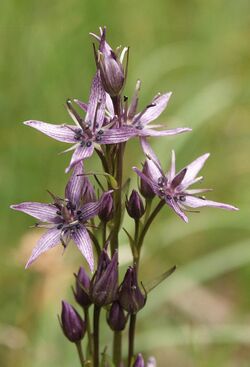Biology:Swertia
| Swertia | |
|---|---|

| |
| Swertia perennis | |
| Scientific classification Error creating thumbnail: Unable to save thumbnail to destination
| |
| Kingdom: | Plantae |
| Clade: | Tracheophytes |
| Clade: | Angiosperms |
| Clade: | Eudicots |
| Clade: | Asterids |
| Order: | Gentianales |
| Family: | Gentianaceae |
| Subtribe: | Swertiinae |
| Genus: | Swertia L. |
| Type species | |
| Swertia perennis L.
| |
| Species | |
|
120–150; see text | |
| Synonyms[1][2][3] | |
Probable synonyms
Possible synonyms
| |
Swertia is a genus in the gentian family containing plants sometimes referred to as the felworts.[4] Some species bear very showy purple and blue flowers.[5][6] Many members of this genus have medicinal and cultural purposes.[7]
Plants of genus Frasera are sometimes considered part of this genus, sometimes as a separate genus, and sometimes as synonymous.
Selected species
Species in the genus Swertia include, but are not limited to:[1][8]
- Swertia angustifolia Buch.-Ham. ex D. Don
- Swertia bimaculata (Siebold & Zucc.) C. B. Clarke
- Swertia bimaculata (Siebold & Zucc.) Hook. f. & Thoms.
- Swertia calcicola Kerr.
- Swertia chinensis (Griseb.) Franch.
- Swertia diluta (Turcz.) Benth. & Hook. f.
- Swertia chirayita (Roxb. ex Fleming) H. Karst.
- Swertia chirata (Wall.) C. B. Clarke
- Swertia ciliata (D. Don ex G. Don) B. L. Burtt.
- Swertia cordata (Wall. ex G. Don) C.B. Clarke
- Swertia dilatata C. B. Clarke
- Swertia hookeri C. B. Clarke
- Swertia japonica (Roem. & Schult.) (Makino) (known by the common names Japanese felwort and Japanese star swertia.)
- Swertia leduci Franch.
- Swertia mileensis T. N. Ho & W. L. Shih
- Swertia macrosperma C. B. Clarke
- Swertia multicaulis D. Don
- Swertia nervosa (G. Don) C. B. Clarke
- Swertia perennis L.
- Swertia punicea Hemsl.
- Swertia purpurascens (D. Don) A. Wall ex E. D. Clarke
- Swertia striata Collett & Hemsl.
- Swertia tibetica Batal.
- Swertia tongluensis Burkill
Chemical constituents
Swertia contains the chemicals sawertiamarine, mangeferin and amarogenitine[9] 1,5,8-trihydroxy-3-methoxyxanthone, 1-hydroxy-2,3,5,7-tetramethoxyxanthone, 1-hydroxy-3,5,8-trimethoxyxanthone, 1-hydroxyl-2,3,4,6-tetramethoxyxanthone, 1-hydroxy-2,3,4,7-tetramethoxyxanthone, 1,8-dihydroxy-3,5-dimethoxyxanthone, 1,7-dihydroxy-3,8-dimethoxyxanthone, 1,3,5,8-tetrahydroxyxanthone, balanophonin, oleanolic acid, maslinic acid, and sumaresinolic acid.[10] Swerilactones from Swertia mileensis showed anti-hepatitis B virus activity in vitro.[11]
Traditional medicine
Swertia is used in Indian Ayurvedic Herbal System to cure Fever as in Laghu sudarshana churna, Maha sudarshan Churna and in Tibetan folk medicine.[12][full citation needed] It is also one of the most widely used medicinal plants of Sikkim, and is considered Vulnerable based on IUCN CAMP Criteria.[13]
References
- ↑ 1.0 1.1 Germplasm Resources Information Network (GRIN) (2004-09-23). "Genus: Swertia". Taxonomy for Plants. USDA, ARS, National Genetic Resources Program, National Germplasm Resources Laboratory, Beltsville, Maryland. http://www.ars-grin.gov/cgi-bin/npgs/html/genus.pl?11742.
- ↑ "Index Nominum Genericorum database". International Code of Botanical Nomenclature. Smithsonian Institution. 1978. http://botany.si.edu/ing/INGsearch.cfm?searchword=Swertia.
- ↑ "Linnaean Name: Swertia perennis Linnaeus". The Linnaean Plant Name Typification Project. Natural History Museum. http://internt.nhm.ac.uk/jdsml/research-curation/projects/linnaean-typification/detail.dsml?ID=870100.
- ↑ "Swertia". Natural Resources Conservation Service PLANTS Database. USDA. https://plants.usda.gov/core/profile?symbol=SWERT. Retrieved 4 December 2015.
- ↑ "Archived copy". http://www.iisc.ernet.in/~currsci/aug252005/635.pdf.
- ↑ "Archived copy". http://www.ansab.org/UserFiles/chiraito.pdf.
- ↑ O'Neill, A. R.; Badola, H.K.; Dhyani, P. P.; Rana, S. K. (2017). "Integrating ethnobiological knowledge into biodiversity conservation in the Eastern Himalayas". Journal of Ethnobiology and Ethnomedicine 13 (1): 21. doi:10.1186/s13002-017-0148-9. PMID 28356115.
- ↑ Porcher, Michel H. (2004). "Sorting Swertia names". Multilingual Multiscript Plant Name Database. The University of Melbourne. http://www.plantnames.unimelb.edu.au/Sorting/Swertia.html.
- ↑ Journal of Ethnopharmacology 98 (2005) 31–35
- ↑ "Chemical constituents from herbs of Swertia mileensis". Zhongguo Zhong Yao Za Zhi 33 (23): 2790–2793. 2008. PMID 19260313.
- ↑ "Swerilactones L-O, secoiridoids with C₁₂ and C₁₃ skeletons from Swertia mileensis". J Nat Prod 74 (8): 1822–1825. 2011. doi:10.1021/np200256b. PMID 21823575.
- ↑ Variation of active constituents of an important Tibet folk medicine Huiling Yang, Chenxu Ding, Yuanwen Duan, Jianquan Liu
- ↑ O'Neill, Alexander (2017-03-29). "Integrating ethnobiological knowledge into biodiversity conservation in the Eastern Himalayas". Journal of Ethnobiology and Ethnomedicine 13 (21): 21. doi:10.1186/s13002-017-0148-9. PMID 28356115.
External links
Wikidata ☰ Q163970 entry
 |

